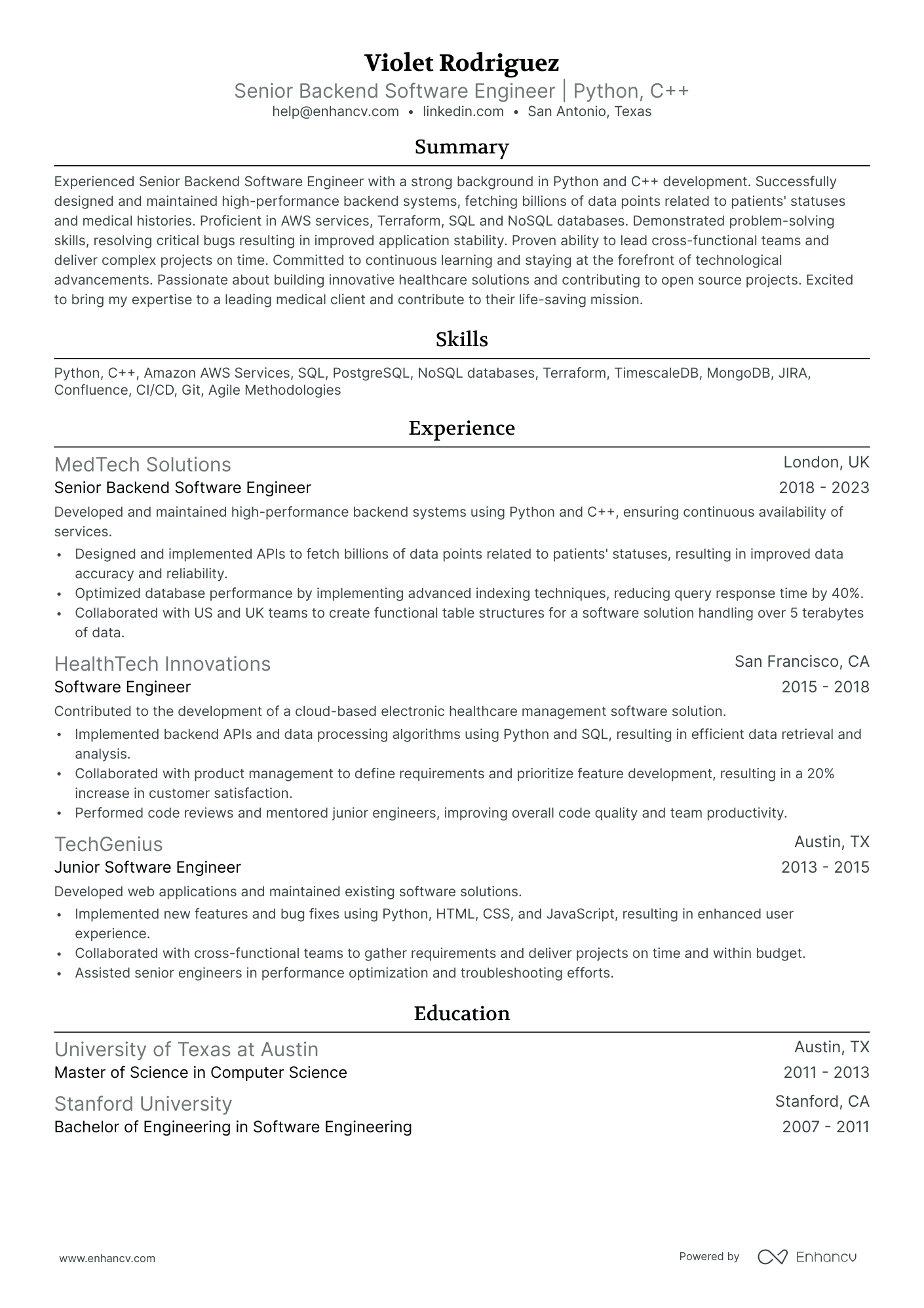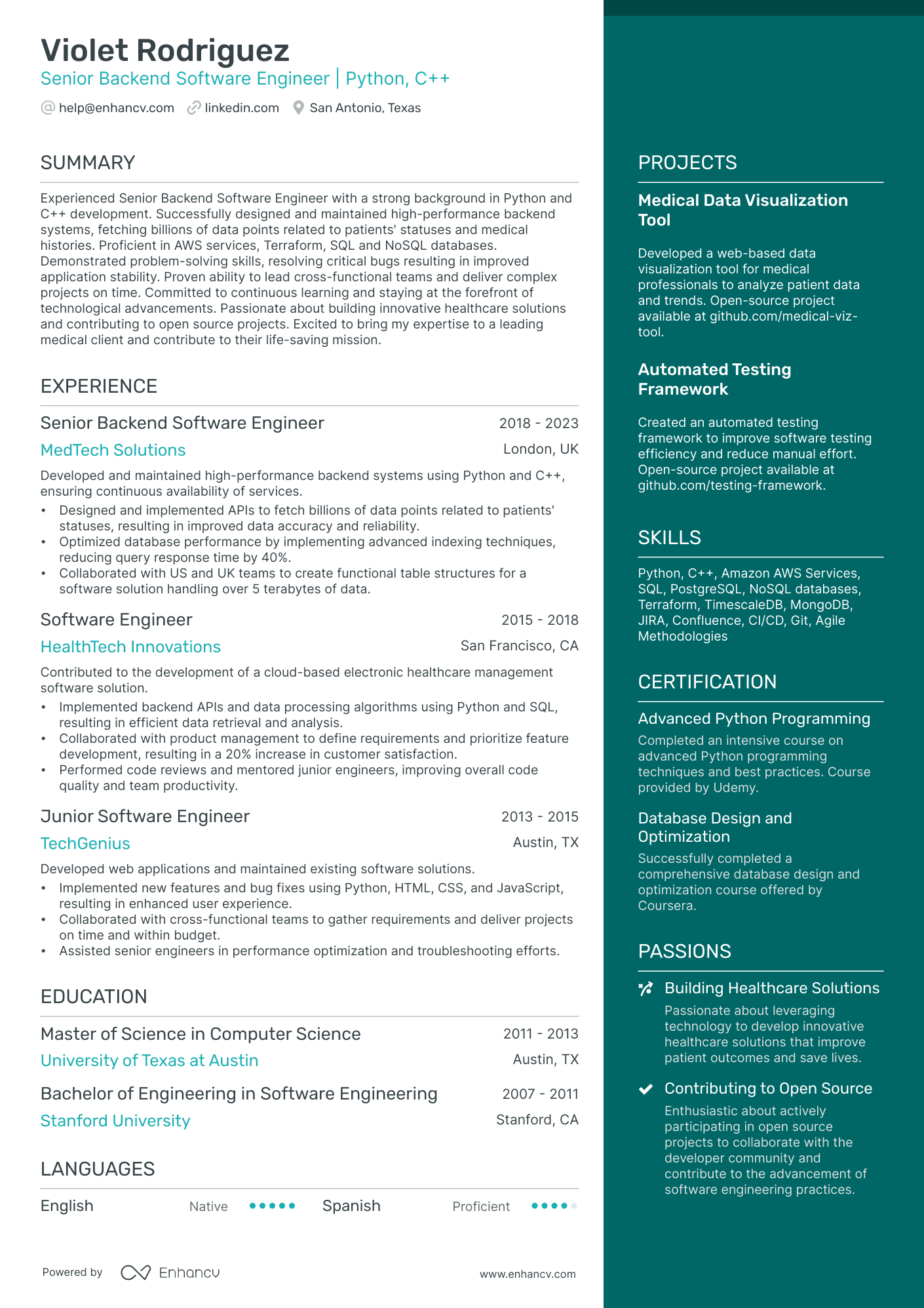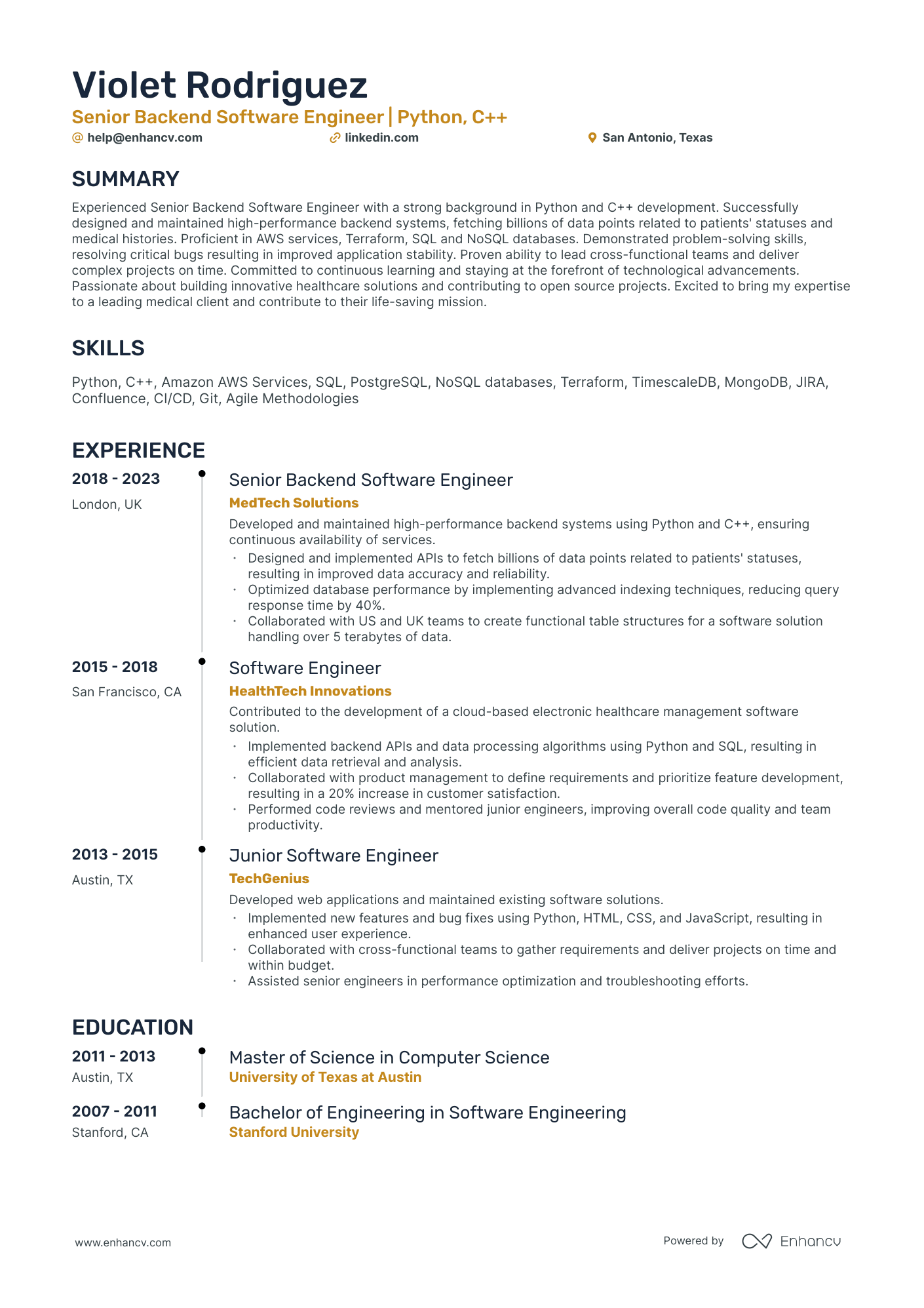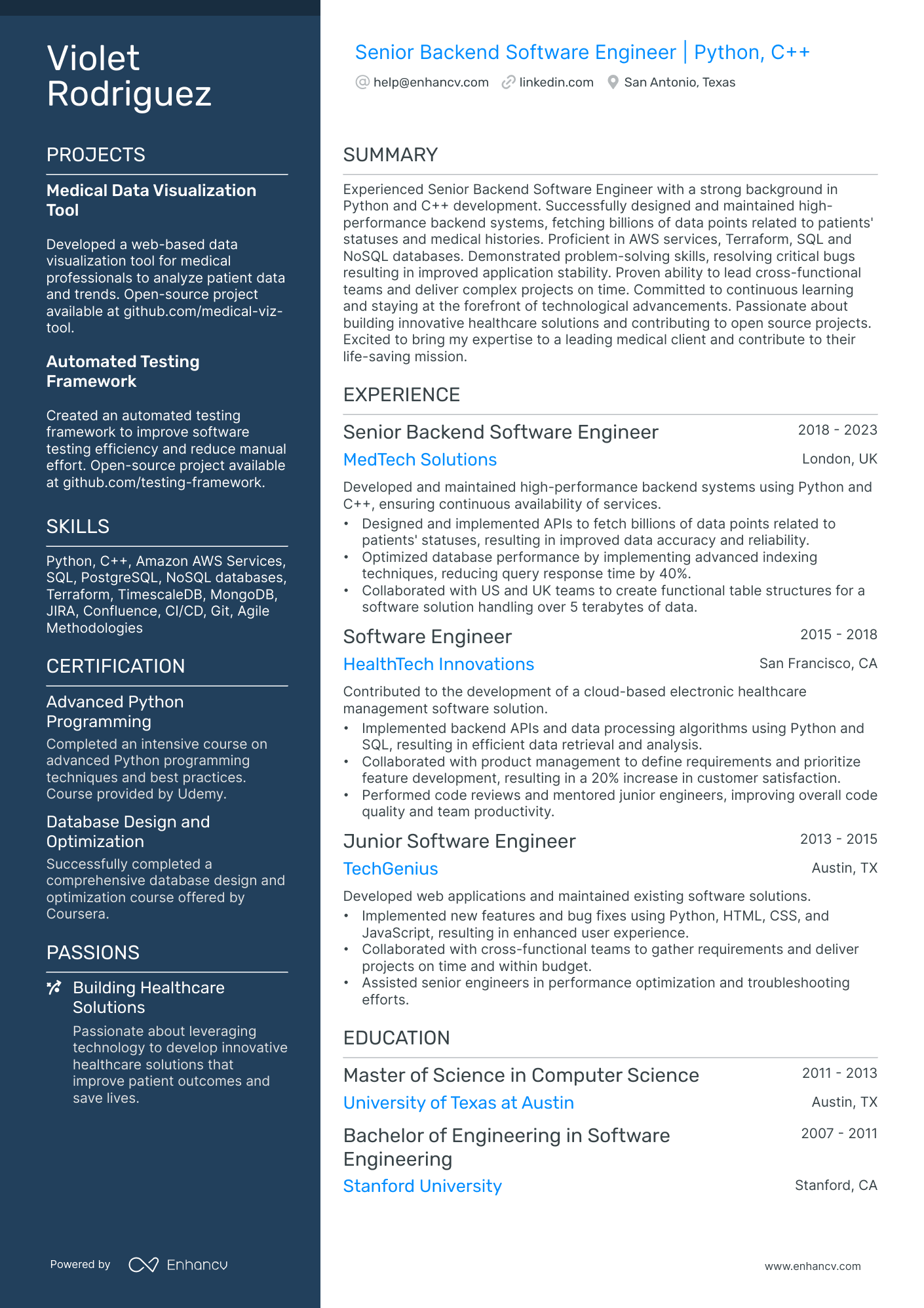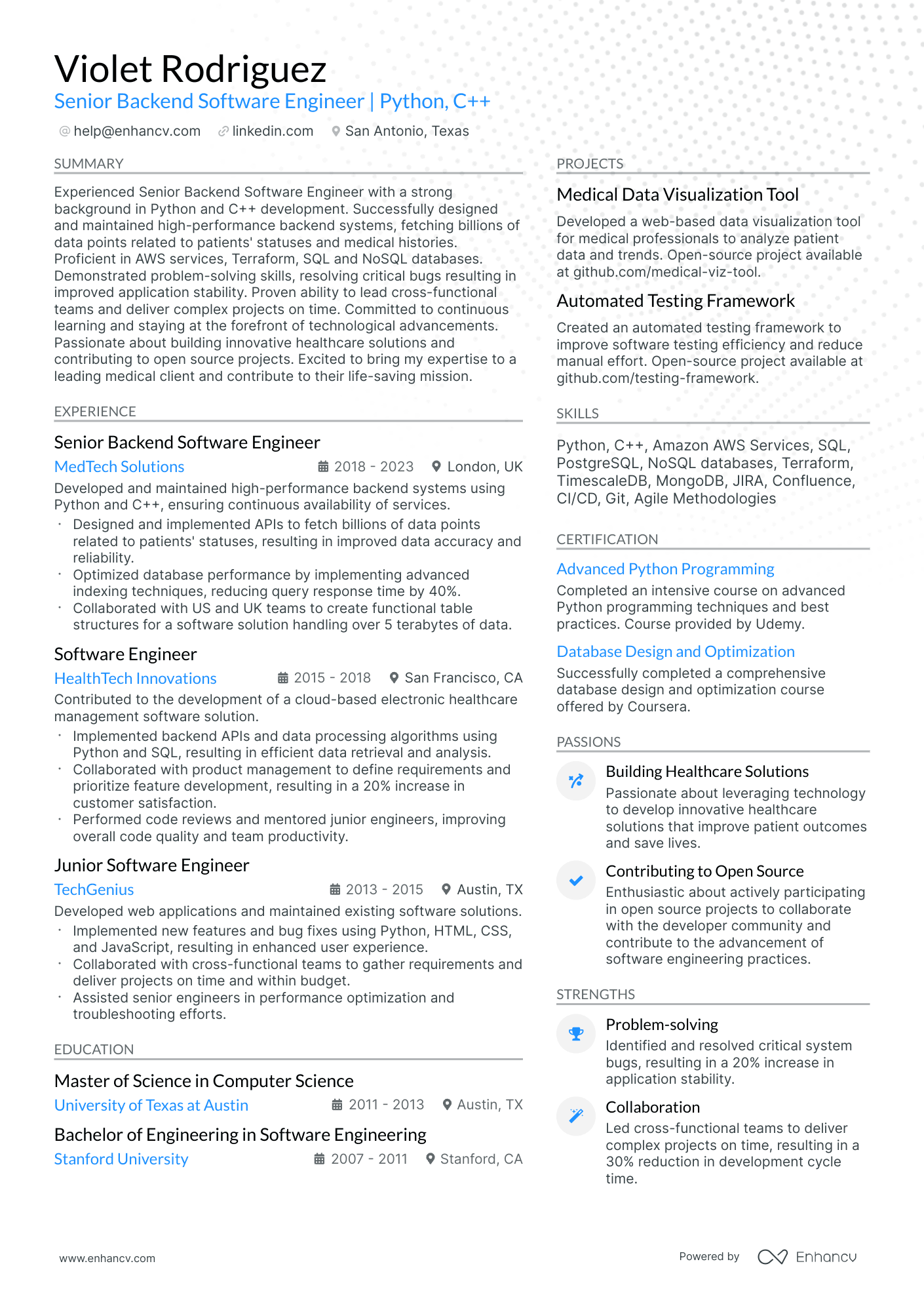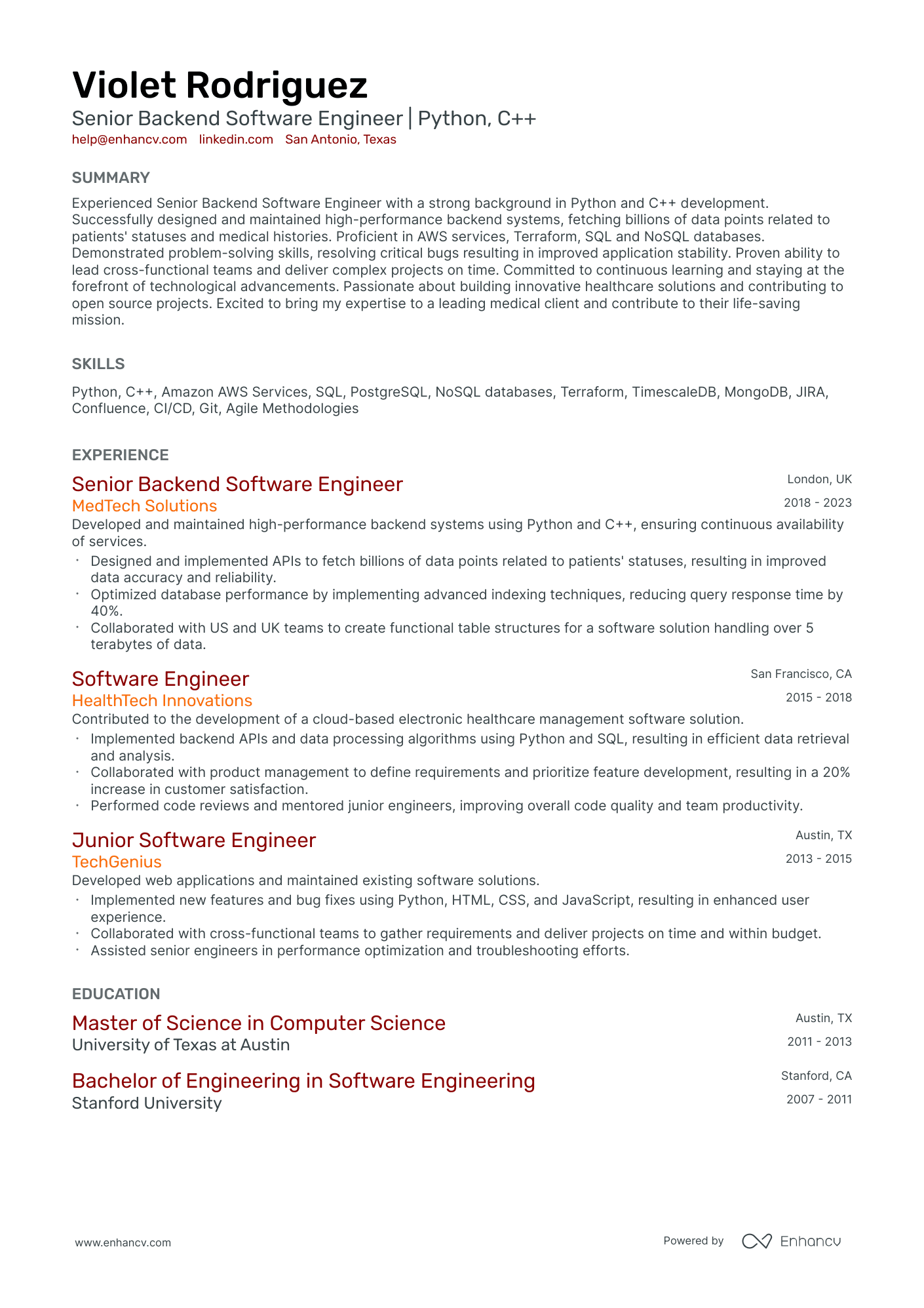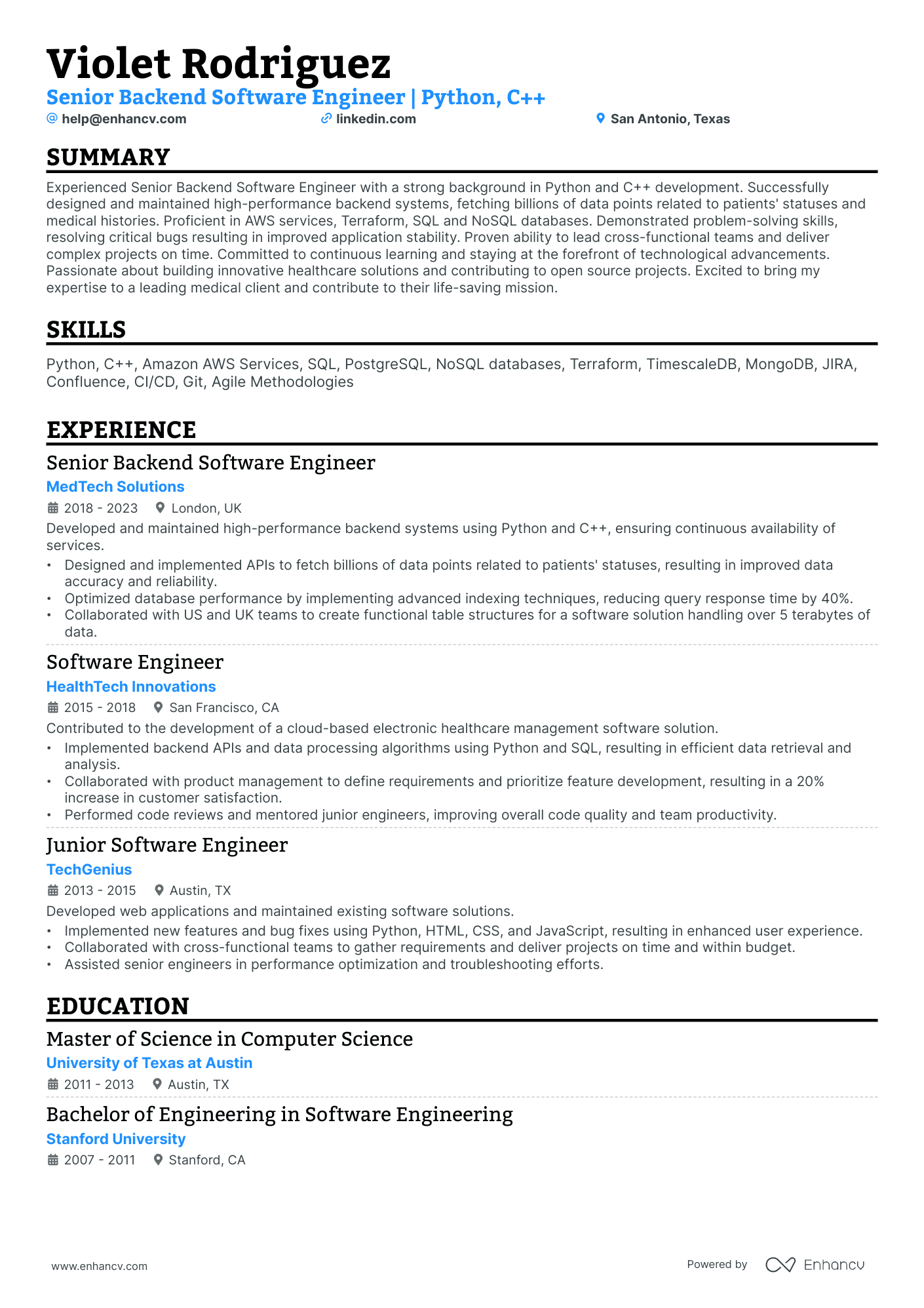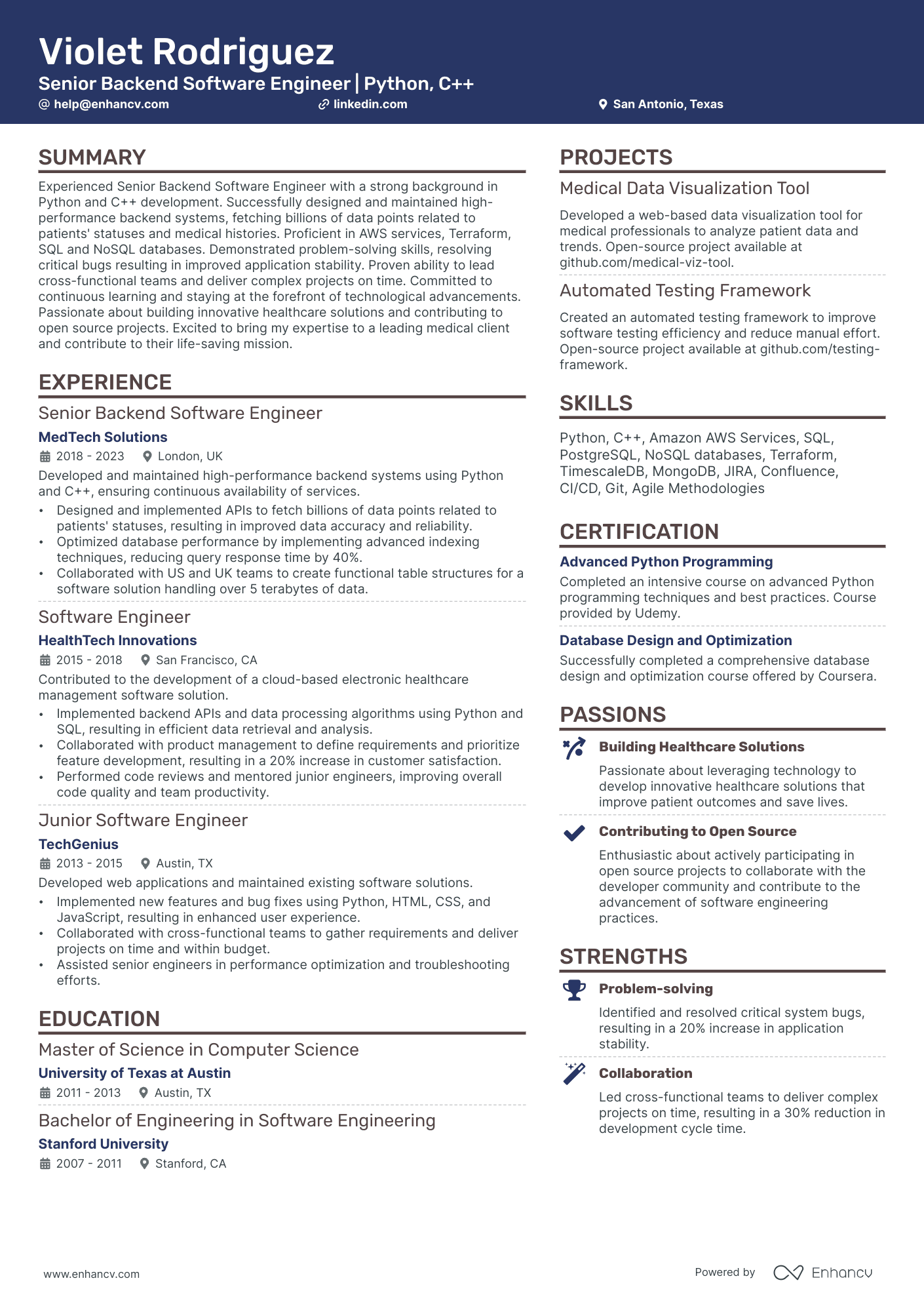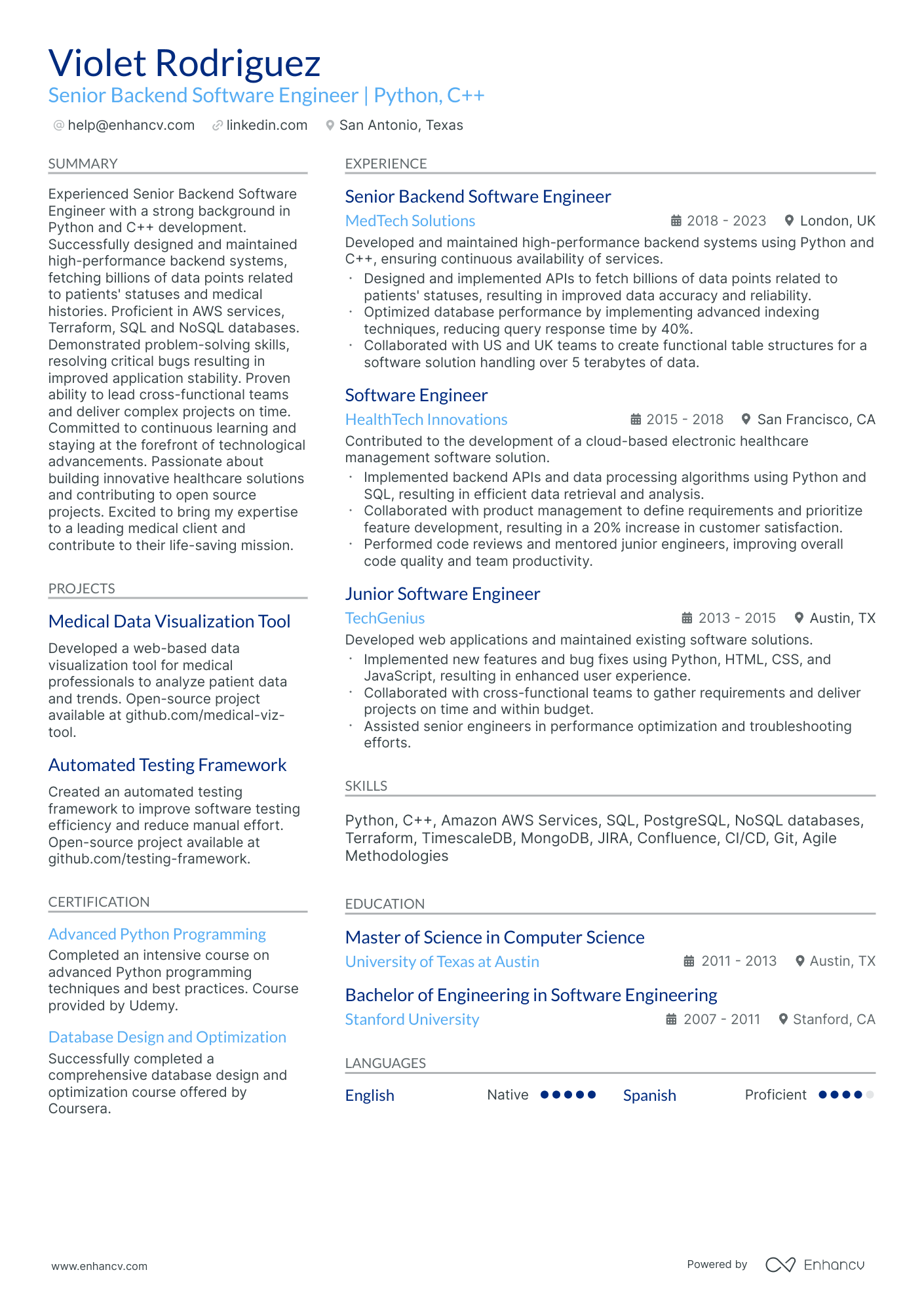One specific challenge faced by an AWS developer when crafting their resume is demonstrating the technical skills and hands-on experiences with AWS services in a manner that is easy for non-technical hiring managers to understand. Our guide provides comprehensive strategies and templates to help articulate these complex competencies into clear, concise language, making it easier for candidates to highlight their AWS proficiency effectively to both technical and non-technical reviewers.
Dive into our comprehensive guide to crafting a standout AWS developer resume:
- Discover AWS developer resume samples that have secured positions at top-tier companies.
- Master the aesthetics of your resume layout for maximum impact.
- Strategically present your achievements and skills across various resume sections.
- Convey to recruiters why you're the perfect fit for the job.
crafting an impeccable AWS developer resume format in four steps
Your AWS developer resume format should be both strategic and reader-friendly. Here's a concise guide to help you achieve that:
- Choose a format that aligns with the job's requirements. If your expertise is directly relevant, the reverse-chronological format is ideal. If you're focusing more on skills, consider the functional or hybrid formats.
- Header: Ensure it's populated with accurate contact details and any relevant portfolio links.
- Length: A one-page resume is standard, but if you have extensive experience, extending to two pages is acceptable.
- File type: To maintain formatting consistency, always opt for PDF.
Your resume should match the market – Canadian applications, for instance, may use a different layout.
Upload your resume
Drop your resume here or choose a file. PDF & DOCX only. Max 2MB file size.
Pro tip
Consider incorporating design elements like icons or charts to enhance your resume's visual appeal and readability. But remember, the key is subtlety; don't let design overshadow content.
Elevate your AWS developer resume with these essential sections:
- Header: The go-to section for recruiters seeking your contact details, portfolio, or current role.
- Summary or objective: A snapshot of your achievements and aspirations.
- Experience: A testament to your technical and interpersonal prowess.
- Skills: A showcase of your capabilities aligned with the job requirements.
- Certifications/Education: A reflection of your commitment to staying updated in the industry.
What recruiters want to see on your resume:
- Proficiency in AWS Services: Knowledge of various AWS core services such as EC2, RDS, S3, Lambda, and more.
- Coding Skills: Proficiency in programming languages like Python, Java, or Node.js, important for scripting and automation tasks.
- Experience with Infrastructure as Code (IaC): Familiarity with AWS CloudFormation or third-party tools like Terraform.
- Understanding of DevOps Practices: Experience with CI/CD pipelines, ideally within the AWS ecosystem using tools like AWS CodePipeline, CodeBuild, etc.
- Security Knowledge: Understanding of AWS security best practices, IAM roles, and policies.
Recommended reads:
Detailing your relevant experience on your AWS developer resume
Showcase your credibility in the resume experience section. For an effective AWS developer resume:
- Highlight measurable achievements.
- Scan the job advert for keywords and integrate them throughout your experience section.
- Emphasize your technical proficiencies and how you've applied them in various roles.
- Keep it simple: mention your responsibility, relevant skills, and the outcomes.
- Use this section to convey your unique value, soft skills, feedback received, and the type of company culture you thrive in.
Top professionals ensure their experience section offers a captivating look at their expertise. Check out our sample AWS developer resumes for guidance.
- Developed scalable and cost-effective AWS solutions for a leading e-commerce company, resulting in a 30% decrease in infrastructure costs.
- Migrated legacy systems to AWS cloud, improving system performance and reducing downtime by 40%.
- Implemented CI/CD pipelines using AWS CodePipeline, automating the deployment process and saving 20 man-hours per week.
- Collaborated with cross-functional teams to design and develop a serverless architecture using AWS Lambda, resulting in a 50% reduction in infrastructure management efforts.
- Designed and implemented highly available and fault-tolerant AWS solutions for a global finance company, ensuring 99.99% uptime.
- Optimized database performance by implementing AWS RDS and DynamoDB, resulting in a 25% improvement in query response times.
- Developed RESTful APIs using AWS API Gateway, allowing seamless integration with third-party services and enabling new business partnerships.
- Led a team of developers in the migration of a monolithic application to a microservices architecture on AWS ECS, increasing development speed and scalability.
- Built data lakes on AWS S3 and implemented ETL processes using AWS Glue, enabling efficient data processing and analysis.
- Implemented security best practices and performed regular audits on AWS infrastructure, ensuring compliance with industry standards.
- Developed serverless web applications using AWS Lambda, API Gateway, and DynamoDB, resulting in a 30% decrease in hosting costs.
- Designed and implemented disaster recovery solutions using AWS services, minimizing data loss and achieving a recovery time objective of under 1 hour.
- Implemented cost optimization strategies for AWS resources, resulting in a 20% reduction in monthly expenditure.
- Integrated AWS IoT services with existing systems, enabling real-time monitoring and control of IoT devices.
- Developed and deployed scalable web applications on AWS Elastic Beanstalk, improving application performance and scalability.
- Collaborated with DevOps teams to automate infrastructure provisioning using AWS CloudFormation, reducing deployment time by 50%.
- Designed and implemented highly available and fault-tolerant architecture on AWS EC2 and ELB, ensuring uninterrupted service for a high-traffic website.
- Optimized AWS infrastructure for cost-efficiency, resulting in a 15% reduction in monthly AWS bills.
- Developed custom AWS Lambda functions to process and analyze large volumes of data, improving data insights and decision-making.
- Migrated on-premises infrastructure to AWS cloud, resulting in improved scalability and reduced maintenance efforts.
- Implemented AWS machine learning services to develop predictive models, increasing customer retention by 25%.
- Designed and implemented secure data transfer mechanisms using AWS Direct Connect and VPN, ensuring data privacy and compliance.
- Developed infrastructure-as-code using AWS CloudFormation, enabling consistent and reproducible deployments across multiple environments.
- Collaborated with cross-functional teams to architect and implement a scalable serverless application using AWS Lambda and DynamoDB.
- Created highly available and fault-tolerant AWS solutions using Auto Scaling, Elastic Load Balancing, and Route 53, ensuring uninterrupted service for a media streaming platform.
- Optimized AWS infrastructure for performance and cost using AWS CloudWatch and Auto Scaling, resulting in a 30% decrease in infrastructure costs.
- Developed and maintained CI/CD pipelines using AWS CodePipeline and Jenkins, improving deployment efficiency and reducing time-to-market by 40%.
- Implemented serverless microservices architecture using AWS Lambda and API Gateway, enabling rapid development and scalability.
- Designed and implemented scalable and fault-tolerant AWS solutions using EC2, S3, and CloudFront for a global content delivery network.
- Implemented data replication and backup strategies using AWS S3 and Glacier, ensuring data durability and availability.
- Developed event-driven architectures using AWS Lambda and SNS, enabling real-time data processing and notifications.
- Collaborated with cross-functional teams to design and implement a serverless data analytics platform on AWS, providing actionable insights to stakeholders.
- Implemented serverless architecture using AWS Lambda and DynamoDB, resulting in improved scalability and reduced operational costs by 40%.
- Developed and deployed containerized applications using AWS ECS and EKS, improving application performance and ease of deployment.
- Optimized AWS infrastructure for high availability and fault tolerance using multi-region configurations and AWS Auto Scaling.
- Led the migration of a monolithic application to AWS microservices architecture, improving development agility and scalability.
- Designed and implemented scalable and secure AWS solutions for a healthcare technology company, ensuring HIPAA compliance.
- Implemented AWS services like EMR and Redshift for big data processing and analysis, improving decision-making capabilities.
- Developed automated backup and disaster recovery processes using AWS services, minimizing data loss and downtime.
- Collaborated with DevOps teams to automate infrastructure deployments using AWS CloudFormation and Ansible, reducing deployment time by 50%.
Quantifying impact on your resume
<ul>
Strategies for candidates with limited or no experience
Even if you're light on experience, other facets of your AWS developer resume can resonate with job requirements:
- Education: Detail skills acquired that dovetail with job expectations.
- Internships & Temporary Roles: Spotlight roles that underscore your relevant expertise.
- Skills: Address both foundational and nuanced job qualifications.
- Strengths & Achievements: Illuminate the distinct value you bring, even if you're newer to the industry.
Recommended reads:
Pro tip
When detailing your career journey, there's no need to delve deep into early roles. Prioritize what resonates with recruiters. For senior positions, a decade-long retrospective can effectively illustrate your evolution.
Highlighting your AWS developer skills
Recruiters look for a mix of technical and personal skills in your AWS developer resume.
Technical or hard skills are specific tools or software you use for the job. They're easy to spot through your education and work achievements.
On the other hand, soft skills like communication or adaptability show how you work with others. They come from both your personal and work life.
To showcase your skills:
- Have a skills section for technical abilities and another for personal strengths.
- Be clear about your skills. Name the exact tools you use and describe how you've used your soft skills.
- Avoid common terms like "Microsoft Office" unless the job specifically asks for them.
- Choose up to ten key skills and organize them in different sections of your resume.
Make your resume pop with top technical and personal skills that recruiters value.
Top skills for your AWS developer resume:
AWS Lambda
Amazon S3
Amazon EC2
AWS CloudFormation
AWS SDKs
Amazon RDS
AWS IAM
AWS API Gateway
Amazon DynamoDB
AWS CloudWatch
Problem Solving
Communication
Team Collaboration
Time Management
Adaptability
Critical Thinking
Attention to Detail
Creativity
Analytical Skills
Customer Focus
Pro tip
If the job emphasizes team or organizational culture, dedicate a section of your resume to underscore your strengths and achievements. Top-tier AWS developer candidates also highlight their alignment with a company's values and culture.
Highlighting education and certification on your AWS developer resume
Your education section is a testament to your foundational knowledge and expertise.
Consider:
- Detailing your academic qualifications, including the institution and duration.
- If you're still studying, mention your anticipated graduation date.
- Omit degrees that aren't pertinent to the job.
- Highlight academic experiences that underscore significant milestones.
For AWS developer roles, relevant education and certifications can set you apart.
To effectively showcase your qualifications:
- List all pertinent degrees and certifications in line with the job requirements.
- Include additional certifications if they bolster your application.
- Provide concise details: certification name, institution, and dates.
- If you're pursuing a relevant certification, indicate your expected completion date.
Your education and certification sections validate both your foundational and advanced knowledge in the industry.
Best certifications to list on your resume
- AWS Certified Cloud Practitioner (CCP) - Amazon Web Services
- AWS Certified Developer - Associate (CDA) - Amazon Web Services
- AWS Certified Solutions Architect - Associate (SAA) - Amazon Web Services
- AWS Certified DevOps Engineer - Professional (DOP) - Amazon Web Services
- AWS Certified Solutions Architect - Professional (SAP) - Amazon Web Services
- AWS Certified Big Data - Specialty (BDS) - Amazon Web Services
- AWS Certified Advanced Networking - Specialty (ANS) - Amazon Web Services
- AWS Certified Security - Specialty (SCS) - Amazon Web Services
- AWS Certified Machine Learning - Specialty (MLS) - Amazon Web Services
Pro tip
If you have basic certificates, place them in the skills or experience section. This saves space for high-demand industry certificates.
Recommended reads:
Should you add a summary or objective to your AWS developer resume?
Choose between:
- Resume summary to match job needs with your top wins.
- Resume objective to share your career goals.
Both should tell recruiters about your best moments. Keep them short, around five sentences. Check out our sample structures for guidance.
Resume summary and objective examples for a AWS developer resume
Optimize your resume summary and objective for ATS
Drop your resume here or choose a file.
PDF & DOCX only. Max 2MB file size.
Additional sections to elevate your AWS developer resume
Recruiters often seek candidates who offer more than just the basics.
To stand out, consider adding:
- Interests: Share hobbies or activities that reveal your personality and transferable skills.
- Projects: Highlight innovative work that showcases your expertise.
- Languages: If communication is vital for the role, showcase your linguistic abilities.
- Awards: Feature significant recognitions that underscore your expertise.
Key takeaways
- A clear resume layout helps present your info well.
- Use all main resume sections to show how you fit the job.
- Detail specific skills or tasks and their impact.
- Show your personality through interests or hobbies.
- List certifications to back up your technical skills.
